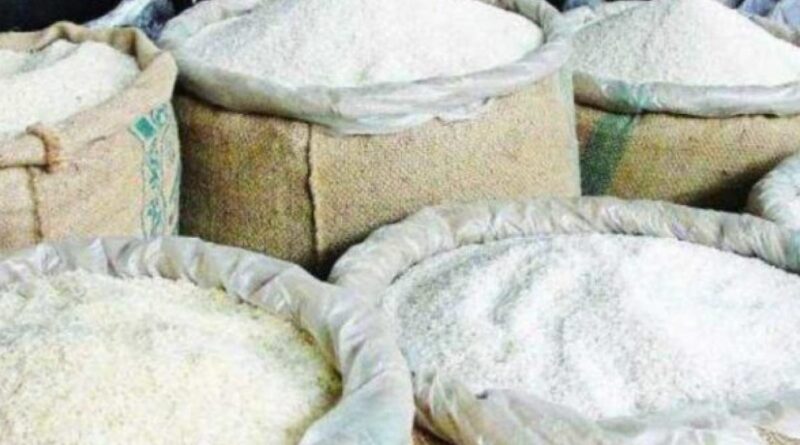‘Major disruptor’: El Niño threatens the world’s rice supplies
Normally by mid-August Thongpoon Moonchansong’s fields are submerged in still waters, with scattered rice plants reaching up to her knees. The waters are usually so abundant that if you plunge a net into the fields, you can draw out fish and crab to eat.
This year, though, things have been different. Rain has been falling in her village in Uttaradit province in the north of Thailand, but it has not been heavy or consistent enough. The canal next to Thongpoon’s family home is dry.
Her family has given up hope of harvesting any rice. “Usually it would be heavy rain and it would be flooded in the canal – this year there has been no water at all. We had to sow dry,” says her daughter, Thanunkan Potudomsin. “Even if it does rain a lot now, the time when the rice would grow to give a yield has already passed,” she says. “It’s all dried up.”
Across south and south-east Asia, unpredictable weather is threatening supplies of rice, a staple food for more than half the world’s population. In July, India, the world’s largest rice exporter, imposed an export ban on non-basmati white rice after crops were damaged by heavy rains. The ban – along with concerns over the arrival of the El Niño phenomenon, which brings hotter, drier weather across the region – has caused prices in key exporting countries Thailand and Vietnam to soar by about 20%, according to a recent Reuters report.
The ripple effects have been felt widely. Over recent weeks, the United Arab Emirates suspended rice exports and re-exports for four months, Myanmar said it plans to temporarily halt exports, and Indonesia said it wants to import more from neighbouring countries to buffer its stocks.
In the Philippines, the government has imposed a rice price cap to protect the poorest consumers, with the country’s National Economic and Development Authority warning of “difficult times” and referring to El Niño as a “major disruptor”.
El Niño is a naturally occurring climate phenomenon in which sections of the Pacific Ocean heat up, typically causing hotter temperatures across many parts of the world. The impact this El Niño will have on rice is unclear. When the last major El Niño event occurred in 2015-2016, south-east Asia experienced an output decline of 15m tonnes of rice compared with the preceding two years, according to a report by the ISEAS-Yusof Ishak Institute, in Singapore. The weather event drove an increase in disease, brought drought and fuelled huge forest and peatland fires that led to a haze crisis across the region.
It is still unclear how severe this El Niño is, says Prof Benjamin Horton, director of the Earth Observatory of Singapore. “The concern is that the rate of warming of ocean temperatures in the Pacific has never been seen before. That indicates that we may get a major El Niño on top of climate change, which would take us really into uncharted territory.
“I hope El Niño is just a little blip,” Horton says. If it isn’t, the prospects for agriculture would be “petrifying”.
A major El Niño would have “significant effects on the air that we breathe; the haze will be so bad that we will not be able to go outside. It will affect the water that we drink – we will not have the availability of water – and it will affect the food that we eat, because we won’t have the food,” says Horton, adding that governments needed to prepare.
Surasri Kidtimonton, the secretary-general of Thailand’s Office of the National Water Resources, predicted in August that the central plains, the country’s rice belt, could face a 40% drop in accumulated rain this season. Indian officials told the media last week that the country was poised for its lowest monsoon rains in eight years.
India accounts for more than 40% of the global rice trade, and supplies many countries in Asia and Africa, where the market for Indian rice has grown over recent years, due to lower prices.
Rice is unlike many other commodities because only a small portion of what’s grown globally – about 11% – is traded, says Joseph Glauber, senior research fellow at the International Food Policy Research Institute in Washington DC. When a very major rice exporter such as India is taken out of the market, then there aren’t a lot of suppliers elsewhere to fill the gap, he added.
“The real question will be whether or not [the monsoons in India] end early and I think that’s always the one of the signs that people will look for as El Niño strengthens,” said Glauber.
The current pressure on rice exports comes at a time when domestic food price inflation is already stubbornly high across much of the world, worsened by Russia’s war in Ukraine. El Niño not only threatens rice production, but many key agricultural products – from palm oil, the world’s most widely used vegetable oil, to India’s sugarcane, soybeans and corn crops.
In Thailand, which has said it has no reason to impose a rice export ban, farmers have been urged to grow crops that consume less water. Campaigns to encourage the public, government and business sectors to use water sparingly will also be launched, local media reported.
Even if El Niño is not as severe as feared, researchers say there is an undeniable need for farmers to adapt to the hotter temperatures brought by the climate crisis. Rice is especially vulnerable. Too little or too much water can destroy a field, and even a seemingly small fluctuation in temperatures can have a dramatic effect. Researchers at the International Rice Research Institute in the Philippines, who studied variations in night-time temperatures, found that each time the minimum temperature rose by just 1C, grain yields declined by 10%. Short, sharp cold snaps can also be deadly.
This article has been republished from The Guardian

